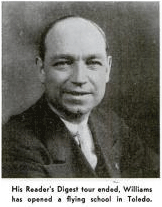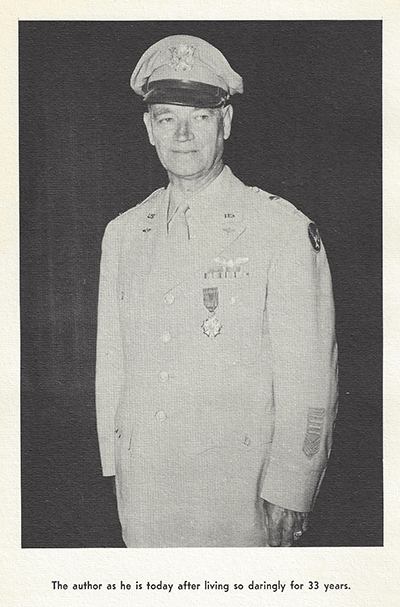OTHER RESOURCES
Very readable volumes about the Grand Central Air Terminal are these books:
Underwood, John. 1984. Madcaps, Millionaires and 'Mose'. Heritage Press, Glendale, CA. 144pp.
And...
Underwood, John. 2007. Grand Central Air Terminal. Arcadia Publishing. Charleston, SC. 127pp.
---o0o---
A very readable, and brief, online history of the Grand Central Air Terminal by Ron DIckson is at the link.
---o0o---
The University of Wyoming holds a collection of Williams' materials described as follows. The link takes you to the finding aid for the collection
"Collection contains materials relating to Williams's aviation career, including blueprints for an Aerocoupe designed by Williams for Yankee Aircraft Corporation; correspondence regarding Williams's flight to Rome, his book Flying to the Moon and Halfway Back, and the Roger Q. Williams School of Aeronautics (1928-1949); newspaper clippings; miscellaneous materials relating to the Roger Q. Williams School of Aeronautics; scrapbooks; stunt flying advertisements; pilot log books; certificates, awards and medals; artifacts; and sketches of Williams and various aircraft. There are also numerous photo files featuring noteworthy aviation persons, places, and things."
YOU CAN HELP
I'm looking for information and photographs of this airplane to include on this page. If you have some you'd like to share, please click this FORM to contact me.
---o0o---
SPONSORED LINKS
HELP KEEP THESE WEB SITES ONLINE
FOR YOUR CONVENIENCE
You may NOW donate via PAYPAL by clicking the "Donate" icon below and using your credit card. You may use your card or your PAYPAL account. You are not required to have a PAYPAL account to donate.
When your donation clears the PAYPAL system, a certified receipt from Delta Mike Airfield, Inc. will be emailed to you for your tax purposes.
---o0o---
ROGER QUINCY WILLIAMS
 |
Roger Williams is signed in the Grand Central Air Terminal (GCAT) Register once, on Sunday, March 22, 1931 at 12:50PM. He flew the aircraft identified as Emsco NC869N. He was solo, and tower Operator Wright added no additional information about the circumstances of the flight except to note "File #4 Washout" written in remarks column. Image, left, from Flying & Popular Aviation magazine, October, 1940
Williams had a long and productive career in aviation. His airplane did not. Within the hour, it crashed in the hands of Clover Field Register pilot Aline Miller, killing her and her passenger. Thus Wright's notation in the Register of "Washout." Please direct your browser to Miller's link, and the links there from, to learn the details of this tragic accident and how it touched the lives of all those she knew.
At the time of his landing, Williams was an employee of Emsco, as cited at the link, “By late 1930 a second management restructuring took place, placing Roger Q. Williams, a famous transatlantic pilot previously associated with the likes of Bellanca, Burnelli-Uppercu and the General Airplanes Corp., as Chief Pilot and Consulting Engineer.” He left Emsco ca. 1932.
 |
Williams was born April 30, 1892 in Brooklyn, NY. He learned to fly at Stratford, CT in 1914. In 1929, he made a non-stop trans-Atlantic flight from Orchard Beach, ME to Spain with Peterson Field Register pilot Lewis Yancey (1895-1940) as navigator. They continued on to Rome, becoming the first aviators to fly from the U.S. to that city. Williams describes this flight in his book, published in 1949 cited in this REFERENCE. Photograph, right, is from his book.
In 1930, Williams made a non-stop, round trip flight from New York City to Bermuda. He departed New York at 5:00AM and, after circling Hamilton, Bermuda without landing, he returned to New York at 10:03PM.
His flight was a harbinger of things to come. On June 16, 1937, Pan American and British Imperial Airways inaugurated flying boat flights from New York to Hamilton. The one way duration of the flights was 4.5-5.5 hours. It was the first time commercial aviation was scheduled from the U.S. to Bermuda, some seven years after Williams' round trip.
Twenty-one years later, the Times of March 18, 1951 reported record ticket sales for the New York to Hamilton run, with 12,000 persons carried on the route during the Easter season. The three airlines on that route at the time were Pan American World airways, Colonial Airlines and Trans-Canada Air Lines. None of these are in service in the 21st century.
Besides his U.S. Transport certificate, he flew with Transport certificate T300, he held F.A.I certificate no. 1682. He was a member of the Quiet Birdmen, National Air Pilots Association, International League of Aviators, World Flyers, American Legion, Chicago Press Club, Royal Aero of Italy, National Parachute Jumpers Association and he was a Mason.
Williams also landed once, on Wednesday, August 2, 1939, and is signed in the Pitcairn Field Register at the link. He flew the aircraft he identified as NC20608, a Fairchild 24J (S/N 3510). His complete biography, including marriages, children and other aviation and business accomplishments, with additional photographs and links, is over on the Pitcairn site at the link.
The University of Wyoming holds a collection of Williams' materials (link to finding aid, left sidebar), including his pilot log books. These logs undoubtedly include record of his landing at Pitcairn Field. At the U.S. Air Force Academy in Colorado Springs there is a scrapbook of newspaper clippings on Lewis Alonzo Yancey and Roger Q. Williams' 1929 trans-Atlantic flight. Based on my research, that scrapbook is probably quite full. He passed away on August 12, 1976 at Alameda, CA. He was 84 years old. Oddly, I could find no obituary for him.
---o0o---
SPONSORED LINKS
THIS PAGE UPLOADED: 01/05/16 REVISED:
